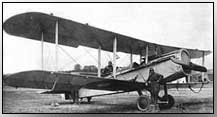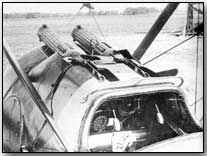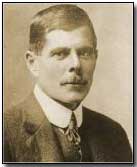The War in the Air - Bombers: Britain
 Just prior to the outbreak of war the RNAS had been given the responsibility
of protecting England from air attack. It was a responsibility they
felt, at the beginning, unprepared for.
Churchill, bleakly prophetic,
told the Cabinet that, "…I cannot feel that our arrangements to cope with it
are yet in a satisfactory state. Loss and injury, followed by much
public outcry, will probably be incurred in the near future."
Just prior to the outbreak of war the RNAS had been given the responsibility
of protecting England from air attack. It was a responsibility they
felt, at the beginning, unprepared for.
Churchill, bleakly prophetic,
told the Cabinet that, "…I cannot feel that our arrangements to cope with it
are yet in a satisfactory state. Loss and injury, followed by much
public outcry, will probably be incurred in the near future."
The threat of Zeppelin attack hung heavy on the minds of Churchill and Captain Murray Suerter, director of the air department of the Royal Navy. Nobody had any idea how to intercept a Zeppelin in the air, and so Churchill and Suerter concentrated on attacking the airship bases.
The Zeppelin sheds were very large, presenting a relatively easy target. If the shed contained an airship at the time, all the better, but destroying these hangers was in itself beneficial. They were essential for storing the Zeppelins which needed protection from high winds when not in flight.
On the 22nd of September four aircraft took off from Antwerp to bomb the Zeppelin sheds at Cologne and Dusseldorf. Due to heavy fog only one of the planes found its target and though the pilot managed to drop his bombs little damage was done.
The RNAS tried again on the 8th of October 1914 with more success, destroying a Zeppelin at Dusseldorf. On November 21st a flight of Avro 504s bombed the Zeppelin works at Friedrichshafen. On Christmas Day, 1914, they flew seven seaplanes off from three seaplane tenders and attempted to attack the Zeppelin sheds at Cuxhaven and Wilhelmshaven.
The raid failed to do much damage, but proved the viability of using ships to extend the bombing range of aircraft. These early experiences prompted the RNAS to order the development of a bomber capable of carrying a large bomb-load. In Suerter's words, the RNAS needed "a bloody paralyzer of an aeroplane."
The innovative Louis Strange of the RFC was also experimenting with bombing techniques. He managed to destroy trucks by dropping petrol bombs from his plane, but dissatisfied with dropping bombs by hand he came up with the idea of attaching the bombs to racks on his wings, and dropping them by pulling a release wire.
He tried this out on his BE2c with great success in March of 1915, attacking a train at the station of Courtrai, and thus impeding the flow of German reinforcements during the Battle of Neuve-Chapelle. This bombing raid was also the first RFC bombing raid that was planned from photo reconnaissance.
 As 1915 progressed the RFC lost control of the air to the German Eindeckers.
The BE2cs, RE7s and Martinsydes suffered increasingly heavy losses until the
British regained control of the air and received the next generation of
aircraft.
As 1915 progressed the RFC lost control of the air to the German Eindeckers.
The BE2cs, RE7s and Martinsydes suffered increasingly heavy losses until the
British regained control of the air and received the next generation of
aircraft.
The most important of these was the Sopwith 1½ Strutter which arrived at the front in early 1916. It was produced both as a two seater fighter and as a single seater bomber. The latter variant carried a 118kg (260 lb) bomb load. Together with the less effective RE8 this plane carried the role of tactical bomber through the transition year of 1916 until more potent bombers arrived on the front.
(As a fighter the 1½ Strutter was also important as it was the first in a chain of winning Sopwith fighter designs culminating in the Camel. The plane's strange designation originated as a nickname, describing the one full inter-plane strut and the additional half strut connecting the upper wing to the fuselage. Nicknaming Sopwith aircraft became something of a tradition. The "Pup" was so nicknamed because it seemed to be a baby, or 'puppy', 1½ Strutter. The "Camel" was named after the way the fuselage "humped" over the breeches of its twin Vickers guns. In each case officialdom had frowned on the names but had been forced to eventually accept them.)
In November of 1916 the RNAS took delivery of the Handley Page O/100. This twin-engined inline tractor plane, with a range of about 965 km (600 miles) and a bomb-load of 812 kg (1,790 lb), was Britain's first multi-engined warplane, and it was the fulfilment of Suerter's request for a "bloody paralyzer".
The RNAS initially used the O/100 for reconnaissance purposes, but from March of 1917 it began using it with great effect as a night bomber against tactical targets. It was joined by the DH4, Britain's most successful day bomber of the war, which had a range of 676 km (420 miles) and could carry a bomb load of 210 kg (460 lb).
One O/100 was flown 3,220 kilometres (2,000 miles) to the island of Lemnos in the Aegean sea, where it took part in an offensive against Turkey. On the 9th of July 1917 it bombed Constantinople. Over the next months it was employed in tactical bombing raids and anti-submarine reconnaissance, but it returned to Constantinople on the 30th of September 1917.
 This raid, however, ended in disaster. Engine failure forced the plane
down and the crew were captured. The pilot of this plane was John
Alcock.
This raid, however, ended in disaster. Engine failure forced the plane
down and the crew were captured. The pilot of this plane was John
Alcock.
A veteran of the RNAS, Alcock had mentored Collishaw of "Black Flight" fame when the latter arrived at the front with less than nine hours flying training. In 1919 John Alcock and Arthur Brown became the first men to fly across the Atlantic non-stop. Brown had also been a prisoner of war, having been captured by the Germans. Sadly, Alcock was to die in an air crash six months after that record breaking flight.
In October 1917 Hugh Trenchard, commander of the RFC in France, was ordered to commence a strategic bombing campaign against German industrial targets. To this end the 41st Wing was formed, taking squadrons from both the RFC and the RNAS. The 41st flew DH4s, O/100s and the venerable Fe2B pusher which was proving its worth as a night bomber and ground strafer. They later began re-equipping with the O/400, an improved version of the O/100 with a 910 kg (2000 lb) bomb load and a range of 965 km (600 miles).
For the first few months the 41st wing concentrated on attacking local targets, but they made their first long-distance raid when 10 Handley-Pages attacked the towns of Mannheim and Ludwigshafen.
By February of 1918 they were capable of mounting the first "round the clock" bombing raid, against the town of Trier, with the DH4s attacking by day and the Handley-Pages attacking by night. In March they carried out a number of day raids, including raids of Mannheim, Mainz and Stuttgart, but this was at the price of six of the Handley-Pages, as the Germans were increasing their anti-aircraft fire and bolstering their fighter defence.
When the RAF was formed on the 1st of April 1918, the decision was made to increase strategic bombing activities. Trenchard was placed in charge of this enlarged force, which became known as the "Independent Force, RAF".
Trenchard preferred to bomb a number of targets, rather than concentrate on one. He also preferred daylight bombing rather than night bombing, as he felt the day bombers were more accurate, but conditions in the field overruled him.
By July of 1918 his day bomber squadrons were suffering too high an attrition rate, and could not operate without fighter escort. The bulk of the bombing effort was eventually carried out by the Handley-Page night bombers, which by September of 1918 were carrying Britain's largest bomb, weighing 750 kg (1,650 lb).
These aircraft dropped two thirds of the 558,000 kg (1,230,000 lb) of bombs dropped by the Independent Force in the latter half of 1918.
At the signing of the armistice the RAF had just taken delivery of its most advanced bomber. The Handley Page V/1500 was a four engined plane that could carry a bomb load of 3,400 kg (7,500 lb) from East Anglia to Berlin, but the plane was never used.
Article contributed by Ari Unikoski
Photographs courtesy of Photos of the Great War website
Next - Bombers - The Missionaries of Bombing
The "Red Baron" was the allied nickname for German air ace Manfred von Richthofen, the leading ace of the war.
- Did you know?
